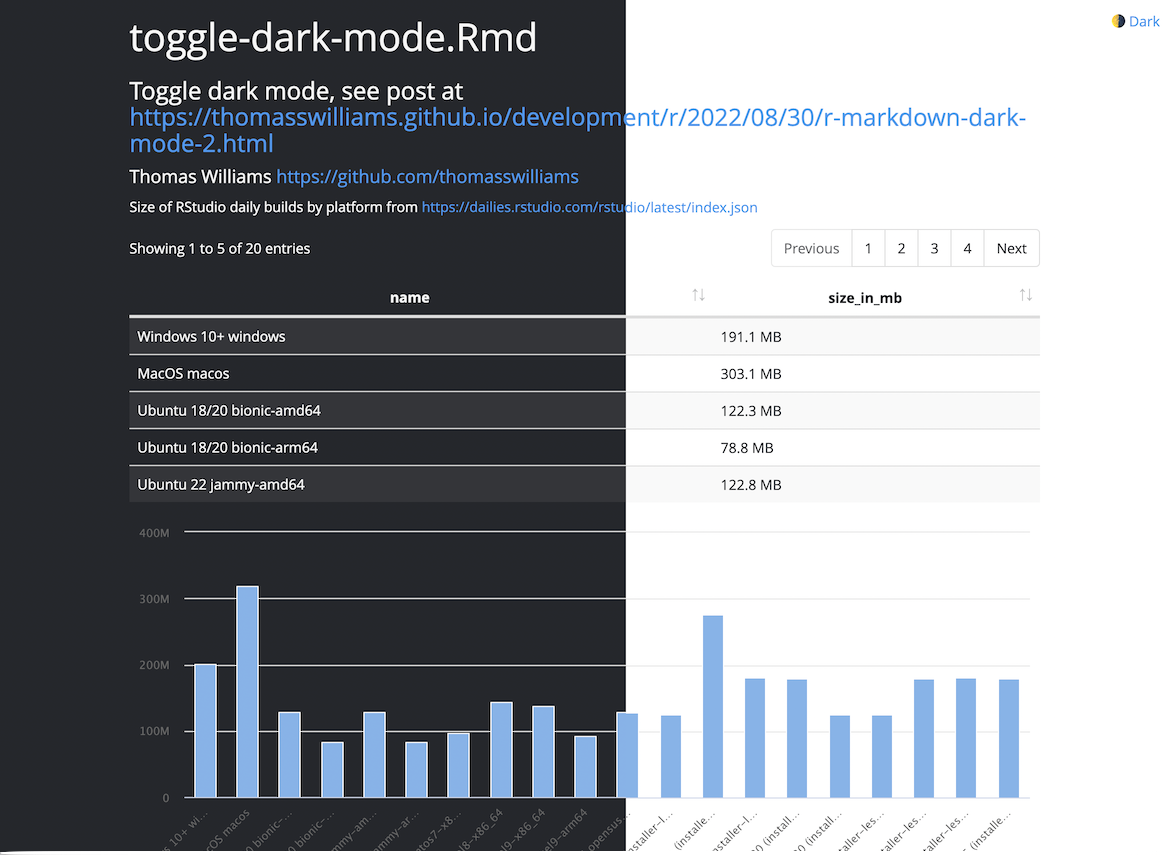In my last R post I described how to automatically detect dark mode in a web-based R Markdown file. In this post, I’ll add a toggle between dark and light mode, and store the user’s choice in browser local storage.
As before, the code in this post can be used with any existing R Markdown light theme, by overriding hard-coded colors to a CSS variable as per the last post.
The end result (at https://github.com/thomasswilliams/r-markdown-snippets/blob/main/toggle-dark-mode.Rmd if you want to skip straight to the code) looks like either the left or right half of:

First, the CSS is different from earlier as dark mode receives its own “dark” class on the HTML document. This simplifies the CSS while still using CSS variables (see the R Markdown file for the CSS).
The next difference is a link in the top right-hand corner which dynamically toggles between light and dark mode using javascript. The link has an id of light-toggle, adapted from code at https://github.com/dandalpiaz/markdown-pages:
<!-- link to toggle between dark & light mode; default is light, so initial text should read "Dark"
adapted from https://github.com/dandalpiaz/markdown-pages -->
<a href="#" role="button" onclick="toggleLight();return false;" id="light-toggle" class="contrast">🌗 Dark</a>
The last piece is using javascript to a) toggle the theme and b) detect dark mode using the system setting and local storage:
// function to toggle between light and dark mode
// adapted from https://github.com/dandalpiaz/markdown-pages
function toggleLight(forceDark) {
// get current theme (default to "light" if not found)
let current_theme = localStorage.getItem('mode') || 'light';
// set new theme to "dark" if current is "light"
let new_theme = (current_theme === 'light') ? 'dark' : 'light';
// special case: if "forceDark", set new theme to "dark"
if (forceDark) {
current_theme = 'light';
new_theme = 'dark';
}
// HTML document element
const htmlEl = document.documentElement;
// add class name for new theme to HTML element
htmlEl.classList.add(new_theme);
// remove class name of old theme from HTML element
htmlEl.classList.remove(current_theme);
// set local storage to new theme
localStorage.setItem('mode', new_theme);
// update theme switcher toggle with id of "light-toggle"
if (new_theme === 'dark') {
document.getElementById('light-toggle').innerHTML = '🌗 Light';
} else {
document.getElementById('light-toggle').innerHTML = '🌗 Dark';
}
}
// set theme on load, adapted from https://radek.io/posts/secret-darkmode-toggle/
// first check "prefers-color-scheme"
const osPreference = window.matchMedia('(prefers-color-scheme: dark)').matches ? 'dark' : 'light';
// next check local storage
const preferredTheme = localStorage.getItem('mode') || osPreference;
// if preferred theme is dark, force theme change, else leave as-is
if (preferredTheme === 'dark') {
toggleLight(true);
}
As a side note, CSS and javascript can easily be added to R Markdown files using three back-ticks and a code type of {css} or {js} (add echo = FALSE to hide the code but still output it to the page).
I hope you’ll find a use for the CSS, HTML and javascript discussed in this post in your own R Markdown files.